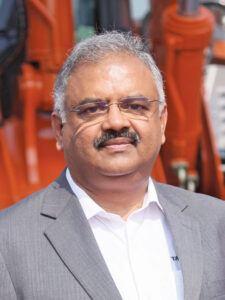Sustainable Construction Equipment Resilience & Readiness For A Greener Future

Sustainable construction equipment refers to equipment that is designed and manufactured to minimize its environmental impact throughout its lifecycle.
Equipment Times looks into the importance of sustainability, types of sustainable construction equipment, technologies, cost of sustainable construction equipment compare to traditional equipment, environmental impact and metrics used to track sustainability and role of sustainable construction equipment in the future of the construction industry.
The construction industry has been criticized for its significant environmental impact, including high energy consumption, waste generation, and carbon emissions. As the world becomes more focused on sustainable development, construction companies are now seeking to reduce their environmental footprint by adopting sustainable practices and using eco-friendly construction equipment.
Sustainable construction equipment refers to equipment that is designed and manufactured to minimize its environmental impact throughout its lifecycle. This includes the sourcing of raw materials, production, transportation, usage, and end-of-life disposal. Here are some innovations in sustainable construction equipment that are helping to make the construction industry more sustainable.
Electric-powered construction equipment
One of the most significant innovations in sustainable construction equipment is the development of electric-powered equipment. Electric-powered construction equipment produces no emissions during operation, making it an ideal choice for indoor projects and urban areas where air quality is a concern. Electric equipment also produces less noise pollution than traditional diesel-powered equipment.
There are several Indian construction equipment companies that have started incorporating electric equipment into their product offerings like Volvo Construction Equipment, Mahindra & Mahindra, JCB India, Liugong India, ACE Construction Equipment, Escorts Construction Equipment, Kobelco Construction Equipment India and others.
Renewable fuel-powered construction equipment
Another option for reducing emissions from construction equipment is to power them with renewable fuels, such as biofuels, hydrogen fuel cells, or compressed natural gas (CNG). These fuels are derived from renewable sources and produce significantly less greenhouse gas emissions than fossil fuels.
Equipment rental and sharing
Renting or sharing equipment is a sustainable option that reduces the need for new equipment production and minimizes waste from discarded equipment. Companies can rent equipment for a specific project instead of purchasing and owning it, reducing their overall carbon footprint.
Recyclable materials
Sustainable construction equipment manufacturers are also designing equipment using recyclable materials, such as aluminum, steel, and plastic. This reduces the amount of waste generated during production and makes it easier to recycle equipment at the end of its lifecycle.
Smart construction equipment
Smart construction equipment incorporates the latest digital technology to optimize performance and reduce energy consumption. Sensors, GPS, and telematics can track equipment usage and provide real-time data on fuel consumption, engine performance, and equipment maintenance, allowing construction companies to identify inefficiencies and optimize performance.
In conclusion, sustainable construction equipment offers a viable solution to reduce the environmental impact of the construction industry. With the increasing demand for sustainable construction practices, construction companies can use these innovative technologies to lower their carbon footprint and contribute to a greener future.
Sustainability, or “greening the fleet,” within construction equipment asset management has transcended to one of the leading initiatives of many organizations around the world. Sustainability, for the most part, is not a new topic, it is simply a series of good business and management practices that will reduce greenhouse gas emissions and harmful waste stream discharges into the physical environment.
Sustainability is not limited to exhaust emissions; it encompasses the equipment, fuels and lubricants, maintenance facilities, mobility, and all other aspects of equipment operation.
Increasing Sustainability
Around the world, the construction industry is prioritizing fleet greening with the introduction of management practices to increase the sustainability of heavy vehicles. Non-road vehicles fuelled by diesel are a major cause of pollution, but, by using cleaner alternatives, the carbon footprint of heavy vehicles can be reduced. As well as switching to greener fuel sources, a sustainability plan should include regular scheduled maintenance to improve the longevity and performance of vehicles, while using fewer vehicles and reducing haul distance will also help construction fleets to become more environmentally-friendly.
Improving Vehicle Longevity with Preventative Maintenance
The maintenance of construction equipment is the cause of around 40% of overrun costs on building projects. The early detection of potential problems with equipment saves time and money and can also maximize the lifespan of expensive machinery. By investing in a robust maintenance schedule and carrying out regular vehicle inspections, businesses can ensure their equipment runs efficiently and therefore avoid any unnecessary and wasteful downtime.
According to ajot.com, among the most important components to check for wear and tear are tracks or tires as these are vital to the running of any machine. Taking good care of large off-road tires and excavator tracks will protect them from damage, improve their performance and extend their useful life. On a large site using multiple vehicles, equipment maintenance software can help operators to log inspections electronically. This means all site workers can check their records and deal promptly with any necessary repairs or replacements.
Installing Technology to Reduce Fuel Consumption
Running heavy equipment and vehicles is expensive and, in some cases, fuel accounts for half the operating costs of a construction vehicle. As well as using more electric heavy vehicles, equipment run on diesel can be fitted with a range of interfaces that help to reduce consumption and make them more energy-efficient. Onboard systems can help operators to carry out tasks quickly and efficiently, saving on fuel, while telematics that track how and when a vehicle is used can ensure that any issues with fuel efficiency are promptly addressed.
Renting Equipment To Limit Carbon Emissions
With more efficient use, the total carbon footprint of a piece of construction equipment can be lowered by between 30% and 50%. One of the best ways to achieve this is through sharing equipment or renting vehicles. When a specialized vehicle such as an excavator or dump truck is rented for a definitive period of time, the rate of utilization is increased, and the number of different pieces of equipment lying idle around a construction site at any one time is minimized. Hiring construction equipment from a local supplier also reduces the fuel costs of transporting heavy equipment from site to site.
Like other sectors with fleets of heavy vehicles, the construction industry is taking steps to reduce its carbon footprint. Off road vehicles are some of the most polluting but, in addition to improving air quality, investing in sustainability programs enable businesses to cut costs, avoid wasteful downtime and make the most of their equipment.
Leaders speak…
 Dimitrov Krishnan, Managing Director, Volvo CE India, said, “Our sustainable construction equipment portfolio is currently using electric drivetrain powered by Lithium-ion batteries. We are also investing in exploration of several other promising technologies such as using Hydrogen as a fuel for ICE machines, Hydrogen fuel cells, Grid-connected-electric machines, efficient hydraulics, and energy recuperation to amplify our sustainable power products portfolio. We have partnered with SSAB to enable us to use fossil-free steel in our machines. We have our group company Volvo Energy which is deeply involved in the circularity aspect of the battery pack right from its production or procurement to its optimization during usage, to its usage after it has served the machine over its usable life, and finally to its end-of-life disposal and recycling.”
Dimitrov Krishnan, Managing Director, Volvo CE India, said, “Our sustainable construction equipment portfolio is currently using electric drivetrain powered by Lithium-ion batteries. We are also investing in exploration of several other promising technologies such as using Hydrogen as a fuel for ICE machines, Hydrogen fuel cells, Grid-connected-electric machines, efficient hydraulics, and energy recuperation to amplify our sustainable power products portfolio. We have partnered with SSAB to enable us to use fossil-free steel in our machines. We have our group company Volvo Energy which is deeply involved in the circularity aspect of the battery pack right from its production or procurement to its optimization during usage, to its usage after it has served the machine over its usable life, and finally to its end-of-life disposal and recycling.”
 Ramesh Palagiri, Managing Director & CEO, Wirtgen India, said, “We take a holistic view of the road construction process chain and, with our Production Systems, offer efficient and sustainable end-to-end solutions that enable a significant reduction of harmful emissions. Our Production Systems use more recycling materials, alternative fuels and combustibles and, depending on the specific application, can also reduce site logistics requirements to the bare necessities. For our customers, this results in the optimisation of their carbon footprint and the cer-tainty of contributing to more sustainability in the road construction process chain.”
Ramesh Palagiri, Managing Director & CEO, Wirtgen India, said, “We take a holistic view of the road construction process chain and, with our Production Systems, offer efficient and sustainable end-to-end solutions that enable a significant reduction of harmful emissions. Our Production Systems use more recycling materials, alternative fuels and combustibles and, depending on the specific application, can also reduce site logistics requirements to the bare necessities. For our customers, this results in the optimisation of their carbon footprint and the cer-tainty of contributing to more sustainability in the road construction process chain.”
 G Sakthikumar, Managing Director, Schwing Stetter India, said, “Our company ensures that the equipment is environmentally friendly throughout its entire lifecycle by following the principles of circular economy. This means that we design the equipment to minimize waste and maximize resource efficiency, we use renewable and recyclable materials in production, we provide repair and maintenance services to extend the lifespan of the equipment, and we recycle or reuse the equipment at the end of its useful life.”
G Sakthikumar, Managing Director, Schwing Stetter India, said, “Our company ensures that the equipment is environmentally friendly throughout its entire lifecycle by following the principles of circular economy. This means that we design the equipment to minimize waste and maximize resource efficiency, we use renewable and recyclable materials in production, we provide repair and maintenance services to extend the lifespan of the equipment, and we recycle or reuse the equipment at the end of its useful life.”
 Rakesh Modi, Chairman, Mtandt Group, said, “Our sustainable construction equipment incorporates advanced technologies and features such as electric or hybrid power, regenerative braking, energy-efficient motors, and the use of recyclable and eco-friendly materials. These features not only reduce the environmental impact of our equipment but also offer significant cost savings and improved performance for our customers.”
Rakesh Modi, Chairman, Mtandt Group, said, “Our sustainable construction equipment incorporates advanced technologies and features such as electric or hybrid power, regenerative braking, energy-efficient motors, and the use of recyclable and eco-friendly materials. These features not only reduce the environmental impact of our equipment but also offer significant cost savings and improved performance for our customers.”
 BKR Prasad, General Manager, Marketing, Tata Hitachi Construction Machinery Company, said, “Tata Hitachi promotes eco-friendly products and services. Apart from ensuring that our wheeled equipments adhere to regulatory requirements of CEV-4 emission norms, we are working to ensure that our excavators are also compatible with emission norms which will be implemented in future. In addition, we also maintain a target of reducing fuel consumption of all our products and models through engineering innovations. With our TL340H PRIME, we are also the first and only manufacturer in India, of hydrostatic wheel loaders that assure fuel savings to the tune of 20% over conventional wheel loaders. Also, our excavators are very well-known in the market for their fuel efficiency.”
BKR Prasad, General Manager, Marketing, Tata Hitachi Construction Machinery Company, said, “Tata Hitachi promotes eco-friendly products and services. Apart from ensuring that our wheeled equipments adhere to regulatory requirements of CEV-4 emission norms, we are working to ensure that our excavators are also compatible with emission norms which will be implemented in future. In addition, we also maintain a target of reducing fuel consumption of all our products and models through engineering innovations. With our TL340H PRIME, we are also the first and only manufacturer in India, of hydrostatic wheel loaders that assure fuel savings to the tune of 20% over conventional wheel loaders. Also, our excavators are very well-known in the market for their fuel efficiency.”
 Subhajit Chandra, Divisional Head, Mobile Crane Division, Liebherr India, said, “Liebherr has accelerated the development of low-emission and zero-emission technologies across its wide range of products, making significant progress along the way. Compared to traditional equipment, it is observed that an electric drivetrain is more efficient than hydraulic solutions – with 90% and 70% efficiency respectively – and also achieves significant savings in energy consumption.”
Subhajit Chandra, Divisional Head, Mobile Crane Division, Liebherr India, said, “Liebherr has accelerated the development of low-emission and zero-emission technologies across its wide range of products, making significant progress along the way. Compared to traditional equipment, it is observed that an electric drivetrain is more efficient than hydraulic solutions – with 90% and 70% efficiency respectively – and also achieves significant savings in energy consumption.”
Hits: 63








